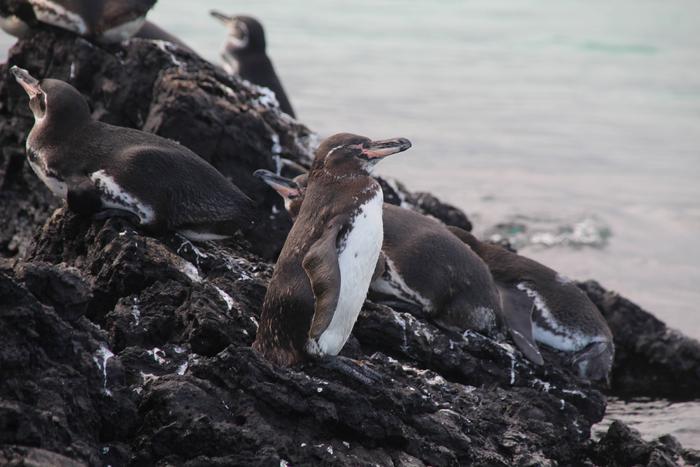Modelling shows how microplastics may bioaccumulate in the Galápagos Islands food web, with Galápagos penguins most affected, according to a study published January 24, 2024 in the open-access journal PLOS ONE by Karly McMullen from the University of British Columbia, Canada, under the supervision of Dr. Juan José Alava and Dr. Evgeny A. Pakhomov of the Institute for the Ocean and Fisheries, University of British Columbia, Canada, and colleagues.

Credit: Karly McMullen, CC-BY 4.0 (https://creativecommons.org/licenses/by/4.0/)
Modelling shows how microplastics may bioaccumulate in the Galápagos Islands food web, with Galápagos penguins most affected, according to a study published January 24, 2024 in the open-access journal PLOS ONE by Karly McMullen from the University of British Columbia, Canada, under the supervision of Dr. Juan José Alava and Dr. Evgeny A. Pakhomov of the Institute for the Ocean and Fisheries, University of British Columbia, Canada, and colleagues.
We know that microplastics are building up in our oceans, but the extent of the damage to marine organisms is still being assessed. Here, McMullen and colleagues focused on the endangered Galápagos penguin (Spheniscus mendiculus) as an indicator species to trace microplastic bioaccumulation and potential biomagnification (a common concept in ecology describing how toxic pollutants further concentrate and amplify with each trophic level of the food web as predators consume prey) through the unique, fairly simple, and isolated Galápagos Islands food web from the Galápagos Marine Reserve.
To simulate microplastic movement through the Galápagos penguin food web, the authors used data collected in October 2021 from seawater around Santa Cruz Island, a human-populated island with urbanized and rural environments, and some islands harboring penguin colonies, zooplankton, penguin prey (barracuda, sardine, herring, salema and anchovy), and penguin scat to feed two models. They built a model focusing specifically on the Galápagos penguin and its diet and leveraged an existing model of the wider Bolivar Channel Ecosystem (located between Fernandina and Isabela islands), of which the Galápagos islands are a part.
Both models showed a rapid increase in microplastic accumulation and contamination across organisms until around year five of the organism’s life, at which point the rate of uptake shifted to a gradual increase and eventual plateau. The Galápagos penguin showed the highest level of microplastics per biomass, followed by barracuda, anchovy, sardine, herring, and salema and predatory zooplankton (in the ecosystem model, predatory zooplankton showed higher concentrations of microplastics than salema). The ecosystem model also predicted biomagnification of microplastics across all predator-prey relationships, with organisms’ rate of excretion the factor most meaningful in affecting the net accumulation rate.
Though whether microplastics truly bioaccumulate within food webs is still under debate, with much more field research required, the authors note that their study points to the excretion/elimination rate as a key to focus on in future work.
Karly McMullen adds: “The model predictions highlight a key knowledge gap in microplastics science, specifically the accumulation behavior and residence time of microplastics in the gut. With microplastics emerging as a prominent ocean pollutant, entering the environment every day, there is a growing concern for marine fauna and coastal wildlife. To understand microplastics’ effects on wildlife and food webs, future research must address how these diverse plastics behave after ingestion.”
Hernán Vargas adds: “The finding of microplastics in the Galápagos penguin, fish prey, and plankton that form part of its food web is undoubtedly worrisome because it shows the globalization of this emerging anthropogenic threat for the conservation of the Galápagos, proving that microplastics can reach isolated and protected areas, such as The Galápagos Archipelago, across thousands of kilometers. Plastic pollution may also affect the public health of human residents inhabiting the islands. As a global threat to ecosystems, global remedies are required to solve it.”
Paola Calle adds: “Having demonstrated the potential bioaccumulation and biomagnification of microplastics in the Galápagos penguin food web alerts us to the potential that these microparticles have on entering and potentially exert adverse effects on the endemic and unique biota of the Galápagos. Therefore, we must raise awareness, actions and public policies that allow us to protect and conserve the endemic and native fauna of the islands.”
J.J. Alava adds: “The ultimate goal of this food web bioaccumulation modeling work is to provide science and data to support risk management of hazardous plastic waste, reduce microplastic emissions in the oceans and marine remote UNESCO Heritage sites such as the Galapagos Islands, and inform local and international marine policy to conserve endangered, endemic seabirds species of Galapagos Marine Reserve.”
#####
In your coverage please use this URL to provide access to the freely available article in PLOS ONE: https://journals.plos.org/plosone/article?id=10.1371/journal.pone.0296788
Citation: McMullen K, Vargas FH, Calle P, Alavarado-Cadena O, Pakhomov E, Alava JJ (2024) Modelling microplastic bioaccumulation and biomagnification potential in the Galápagos penguin ecosystem using Ecopath and Ecosim (EwE) with Ecotracer. PLoS ONE 19(1): e0296788. https://doi.org/10.1371/journal.pone.0296788
Author Countries: Canada, Ecuador
Funding: This research was partially funded by the Nippon Foundation via the Nippon Foundation Marine Litter Project at the Institute for the Oceans and Fisheries, University of British Columbia, awarded to J. J. Alava and E. A. Pakhomov under award number F19-02677 (NIPPFOUN 2019) in collaboration with and via the Nippon Foundation-Ocean Nexus Center (Dr. Yoshitaka Ota) at University of Washington [https://oceannexus.uw.edu/about/]. This research was partially supported by the NSERC Discovery Grant RGPIN-2014-05107 to E. A. Pakhomov [https://www.nserccrsng.gc.ca/professors-professeurs/grants-subs/dgigp-psigp_eng.asp]. Both the Nippon Foundation and NSERC funders had no involvement in the study design, data collection and analysis, decision to publish, or preparation of the manuscript.
Journal
PLoS ONE
DOI
10.1371/journal.pone.0296788
Method of Research
Computational simulation/modeling
Subject of Research
Not applicable
Article Title
Modelling microplastic bioaccumulation and biomagnification potential in the Galápagos penguin ecosystem using Ecopath and Ecosim (EwE) with Ecotracer
Article Publication Date
24-Jan-2024
COI Statement
The authors have declared that no competing interests exist.




